Rhinoplasty- Nasal Tip. Tip Jean Paul Font, MD





















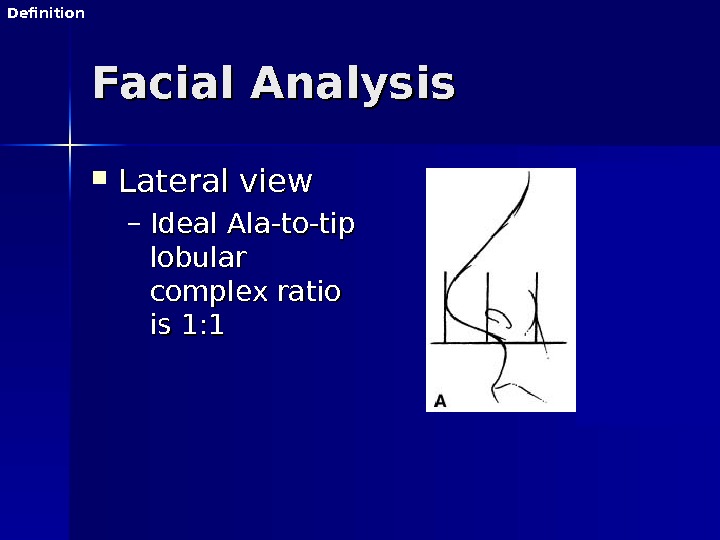

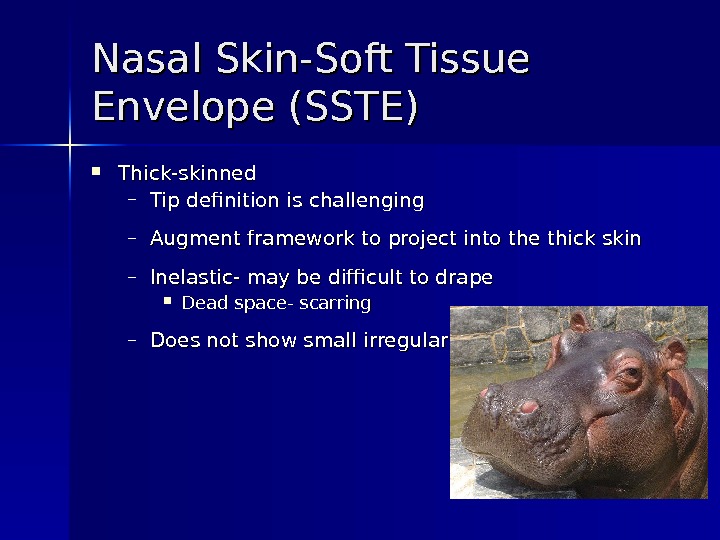


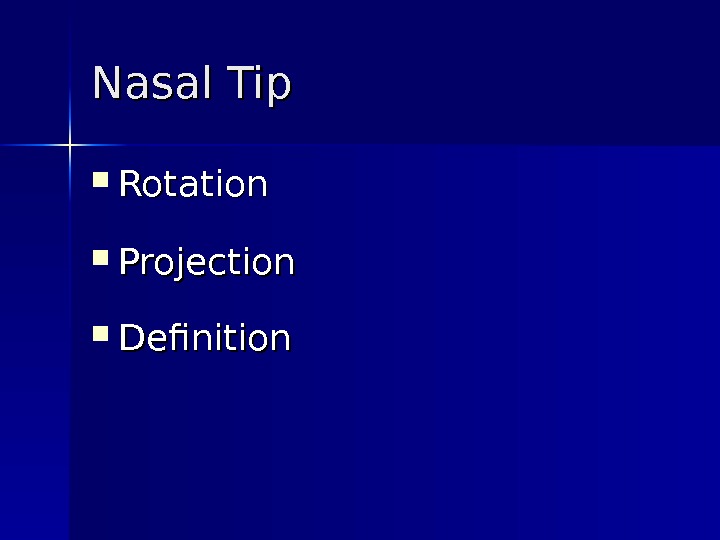





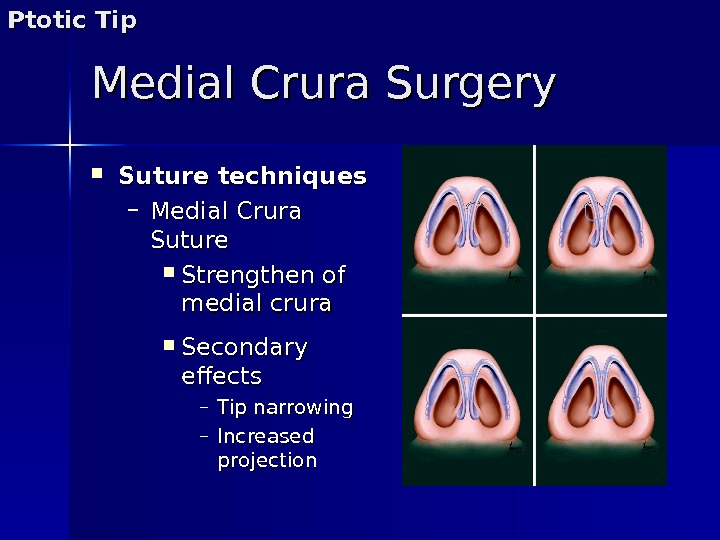




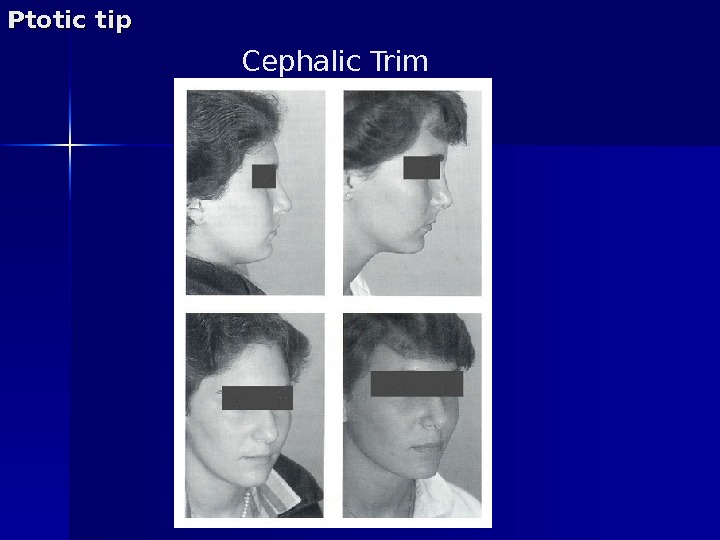





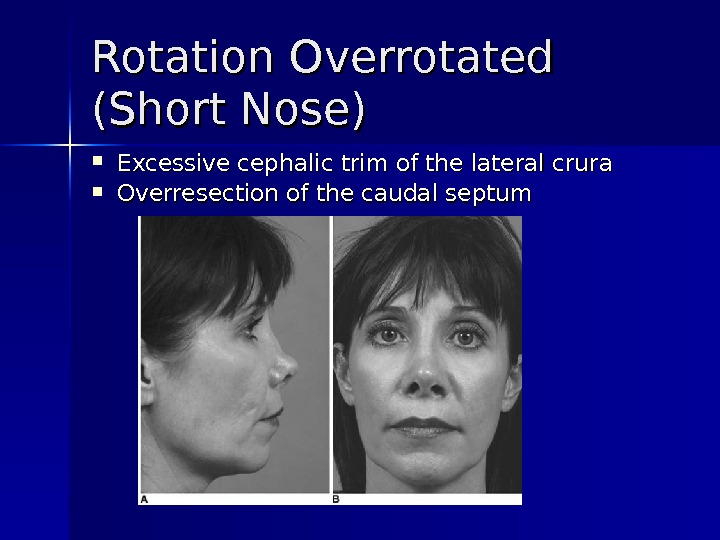





















- Размер: 15.7 Mегабайта
- Количество слайдов: 64
Описание презентации Rhinoplasty- Nasal Tip. Tip Jean Paul Font, MD по слайдам
 Rhinoplasty- Nasal Tip Jean Paul Font, MD Raghu Athre, MD University of Texas Medical Branch Department of Otolaryngology March 31,
Rhinoplasty- Nasal Tip Jean Paul Font, MD Raghu Athre, MD University of Texas Medical Branch Department of Otolaryngology March 31,
 History of Rhinoplasty 500 B. C. , Ancient India, Sushruta – Reconstruct traumatic noses including amputated as a punishment for crimes In 1845, German, Johann Friedrich Dieffenbach – Published a procedure for reduction/straightening a deviated nose using external incisions
History of Rhinoplasty 500 B. C. , Ancient India, Sushruta – Reconstruct traumatic noses including amputated as a punishment for crimes In 1845, German, Johann Friedrich Dieffenbach – Published a procedure for reduction/straightening a deviated nose using external incisions
 History of Modern Rhinoplasty In 1907, Jacques Joseph published his Treatise on Rhinoplasty – Detailed nasal deformities and surgical treatments – Some of these procedures and instruments are used today – Describe the first suture in tip rhinoplasty, the orthopedic suture Consider by many as the father of modern facial plastic surgery
History of Modern Rhinoplasty In 1907, Jacques Joseph published his Treatise on Rhinoplasty – Detailed nasal deformities and surgical treatments – Some of these procedures and instruments are used today – Describe the first suture in tip rhinoplasty, the orthopedic suture Consider by many as the father of modern facial plastic surgery


 Introduction Important considerations in primary rhinoplasty – Airway function – Precise assessment of the deformity – Nasal support mechanisms – Soft tissue skin envelope – Postoperative scar contracture and healing (modifications over the lifetime of the patient)
Introduction Important considerations in primary rhinoplasty – Airway function – Precise assessment of the deformity – Nasal support mechanisms – Soft tissue skin envelope – Postoperative scar contracture and healing (modifications over the lifetime of the patient)
 Pre-Op Assessment Functional airway problems – Medical management- Intermittent obstruction from mucosal inflammation – Surgically correctable Septal deviation or spurs Large turbinates Nasal deformity/deviation Nasal valve collapse Cottle Maneuver Asses Internal Valve
Pre-Op Assessment Functional airway problems – Medical management- Intermittent obstruction from mucosal inflammation – Surgically correctable Septal deviation or spurs Large turbinates Nasal deformity/deviation Nasal valve collapse Cottle Maneuver Asses Internal Valve
 External Valve Collapse of lobule on inspiration Loss of Lower lateral cartilages support Improvement of breathing – Modified Cottle Maneuver
External Valve Collapse of lobule on inspiration Loss of Lower lateral cartilages support Improvement of breathing – Modified Cottle Maneuver
 Palpation of the nose Shape, position, and strength of the nasal structures Trace the LLCs – Position – Stability
Palpation of the nose Shape, position, and strength of the nasal structures Trace the LLCs – Position – Stability
 Tip support- Test Tip Recoil Major tip support mechanisms – Strength of Lower lateral cartilage – Attachment of the medial crura to Septum – Attachment of upper lateral cartilage to alar cartilage Minor tip support mechanisms – Dorsal septum – Interdomal ligaments – Membranous septum – Nasal spine – Surrounding skin and soft tissues – Alar sidewalls
Tip support- Test Tip Recoil Major tip support mechanisms – Strength of Lower lateral cartilage – Attachment of the medial crura to Septum – Attachment of upper lateral cartilage to alar cartilage Minor tip support mechanisms – Dorsal septum – Interdomal ligaments – Membranous septum – Nasal spine – Surrounding skin and soft tissues – Alar sidewalls
 Photographic Documentation Allow for more detailed evaluation Full-face – Frontal – Lateral – Oblique – Base view – Smiling view Close-up views – Skin Assessment
Photographic Documentation Allow for more detailed evaluation Full-face – Frontal – Lateral – Oblique – Base view – Smiling view Close-up views – Skin Assessment
 Frankfort line
Frankfort line
 Nasal Tip Rotation Projection Definition
Nasal Tip Rotation Projection Definition
 Facial Analysis Nasal tip rotation – Along a radius based at the EAC – Rotation increases along the upper portion of the arc
Facial Analysis Nasal tip rotation – Along a radius based at the EAC – Rotation increases along the upper portion of the arc
 Facial Analysis Nasolabial angle – Male 9090 oo to 95 oo – Female 9595 oo to 110 oo. Rotation
Facial Analysis Nasolabial angle – Male 9090 oo to 95 oo – Female 9595 oo to 110 oo. Rotation
 Facial Analysis Nasal projection – Facial plane Vertical line connecting the nasion with alar groove – Nasal tip distance from facial plane (Perpendicular line)
Facial Analysis Nasal projection – Facial plane Vertical line connecting the nasion with alar groove – Nasal tip distance from facial plane (Perpendicular line)
 Facial Analysis Tip projection – Goode’s method – Ratio of B/A 0. 55 to 0.
Facial Analysis Tip projection – Goode’s method – Ratio of B/A 0. 55 to 0.
 Facial Analysis Nasomental angle – Nasal dorsum to tip, Tip to pogonion – 120 to 130 oo Posterior pogonium – Illusion of increase projection
Facial Analysis Nasomental angle – Nasal dorsum to tip, Tip to pogonion – 120 to 130 oo Posterior pogonium – Illusion of increase projection
 Facial Analysis Line dropped from lower lip vermillion – Female = posterior to vertical line – Male = at vertical line Chin Implant – Sagital plane – Does not affect vertical or transverse problems
Facial Analysis Line dropped from lower lip vermillion – Female = posterior to vertical line – Male = at vertical line Chin Implant – Sagital plane – Does not affect vertical or transverse problems
 Facial Analysis Definition Caudal View: – Equilateral Triangle – Divided into three equivalent unit – Tip is 1/3 of basal view
Facial Analysis Definition Caudal View: – Equilateral Triangle – Divided into three equivalent unit – Tip is 1/3 of basal view
 Facial Analysis Lateral view – Ideal Ala-to-tip lobular complex ratio is 1: 1 Definition
Facial Analysis Lateral view – Ideal Ala-to-tip lobular complex ratio is 1: 1 Definition
 Computer Image Modification Programs Increasingly popular for consultation of cosmetic patients Valuable – Patient might have unrealistic goals for surgery – Accurate image can focused a reasonable goal Unrealistic images will inevitably lead to an unhappy patient Under-promise, Over-deliver
Computer Image Modification Programs Increasingly popular for consultation of cosmetic patients Valuable – Patient might have unrealistic goals for surgery – Accurate image can focused a reasonable goal Unrealistic images will inevitably lead to an unhappy patient Under-promise, Over-deliver
 Nasal Skin-Soft Tissue Envelope (SSTE) Thick-skinned – Tip definition is challenging – Augment framework to project into the thick skin – Inelastic- may be difficult to drape Dead space- scarring – Does not show small irregularity
Nasal Skin-Soft Tissue Envelope (SSTE) Thick-skinned – Tip definition is challenging – Augment framework to project into the thick skin – Inelastic- may be difficult to drape Dead space- scarring – Does not show small irregularity
 Nasal Skin-Soft Tissue Envelope (SSTE) Thin skin – Irregularities becoming visible or palpable Ensure that all bony, cartilaginous, grafts, and implants are precisely positioned and smoothly contoured – Draping is easier
Nasal Skin-Soft Tissue Envelope (SSTE) Thin skin – Irregularities becoming visible or palpable Ensure that all bony, cartilaginous, grafts, and implants are precisely positioned and smoothly contoured – Draping is easier
 Surgical Approach Endonasal approaches – Ideal for patients with subtle deformities External rhinoplasty – Wider exposure and access afforded
Surgical Approach Endonasal approaches – Ideal for patients with subtle deformities External rhinoplasty – Wider exposure and access afforded
 Nasal Tip Rotation Projection Definition
Nasal Tip Rotation Projection Definition
 Tripod theory First proposed by Anderson JR (1969) Tripod – Lateral cruras= two posterior legs – Conjoined medial cruras = anterior third leg Helps predict the tip rotation – Tilt in the direction of the shorter leg Cephalic rotation – Shortening of the lateral cruras – Lengthening medial cruras
Tripod theory First proposed by Anderson JR (1969) Tripod – Lateral cruras= two posterior legs – Conjoined medial cruras = anterior third leg Helps predict the tip rotation – Tilt in the direction of the shorter leg Cephalic rotation – Shortening of the lateral cruras – Lengthening medial cruras
 Tip Rotation Common presenting situations – Ptotic Tip – Overrrotated nose Techniques to alter tip rotation – Associated with modification of the tripod
Tip Rotation Common presenting situations – Ptotic Tip – Overrrotated nose Techniques to alter tip rotation – Associated with modification of the tripod
 Ptotic Tip Caudal tip rotation Acute nasolabial angle – <Male 90 oo to 95 oo – <Female 95 oo to 110 oo Tip Rotation
Ptotic Tip Caudal tip rotation Acute nasolabial angle – <Male 90 oo to 95 oo – <Female 95 oo to 110 oo Tip Rotation
 Ptotic Tip Inherited Common acquire causes – Nasal trauma – Aging face – Previous rhinoplasty Loss of tip support mechanisms – Loss of integrity of the medial and lateral crura – Loss of attachment of the medial crura to septum – Loss of attachment of upper lateral to lower laterals
Ptotic Tip Inherited Common acquire causes – Nasal trauma – Aging face – Previous rhinoplasty Loss of tip support mechanisms – Loss of integrity of the medial and lateral crura – Loss of attachment of the medial crura to septum – Loss of attachment of upper lateral to lower laterals
 Management of Ptotic Tip Treatment base on Tripod – Strengthening or elongating of the medial crura – Trimming of the lateral crura – Shortening caudal septum – Restore support mechanism
Management of Ptotic Tip Treatment base on Tripod – Strengthening or elongating of the medial crura – Trimming of the lateral crura – Shortening caudal septum – Restore support mechanism
 Medial Crura Surgery Suture techniques – Medial Crura Suture Strengthen of medial crura Secondary effects – Tip narrowing – Increased projection. Ptotic Tip
Medial Crura Surgery Suture techniques – Medial Crura Suture Strengthen of medial crura Secondary effects – Tip narrowing – Increased projection. Ptotic Tip
 Interdomal Suture – Strengthen of medial crura – Secondary effects Tip narrowing Increased projection. Medial Crura Surgery. Ptotic Tip
Interdomal Suture – Strengthen of medial crura – Secondary effects Tip narrowing Increased projection. Medial Crura Surgery. Ptotic Tip
 Medial Crura Surgery Medial crura strut graft – Strengthen of medial crura – Elongate the medial cruras (position dependent) – Cephalic rotation Ptotic Tip
Medial Crura Surgery Medial crura strut graft – Strengthen of medial crura – Elongate the medial cruras (position dependent) – Cephalic rotation Ptotic Tip
 Lateral crura surgery Cephalic trim – Rotates tip cephalically by creating a gap between the LLC and Upper Lateral Cartilage – LLC scars upwards – Improve definition. Ptotic tip
Lateral crura surgery Cephalic trim – Rotates tip cephalically by creating a gap between the LLC and Upper Lateral Cartilage – LLC scars upwards – Improve definition. Ptotic tip
 Cephalic Trim. Ptotic tip
Cephalic Trim. Ptotic tip
 Cephalic Trim. Ptotic tip
Cephalic Trim. Ptotic tip
 Lateral crura surgery Weakened Complete Strips – Augments cephalic rotation – May compromise tip support. Ptotic tip
Lateral crura surgery Weakened Complete Strips – Augments cephalic rotation – May compromise tip support. Ptotic tip
 Interrupted Strip – Spring-tension of LLC is release, and significant rotation can occur – Sacrifices major tip support mechanism, may tip projection. Lateral crura surgery. Ptotic tip
Interrupted Strip – Spring-tension of LLC is release, and significant rotation can occur – Sacrifices major tip support mechanism, may tip projection. Lateral crura surgery. Ptotic tip
 Lateral crura surgery Resuturing – Lateral Crural Overlay Technique increases rotation and decreases projection. Ptotic tip
Lateral crura surgery Resuturing – Lateral Crural Overlay Technique increases rotation and decreases projection. Ptotic tip

 Onlay cartilaginous tip graft. Ptotic tip
Onlay cartilaginous tip graft. Ptotic tip
 Rotation Overrotated (Short Nose) Excessive cephalic trim of the lateral crura Overresection of the caudal septum
Rotation Overrotated (Short Nose) Excessive cephalic trim of the lateral crura Overresection of the caudal septum
 Overrotated (Short Nose) Management – Caudal septal extension graft – Minor deformities Columellar plumping grafts
Overrotated (Short Nose) Management – Caudal septal extension graft – Minor deformities Columellar plumping grafts
 Tip Definition Common presenting situations – Boulbus Tip – Pinch tip
Tip Definition Common presenting situations – Boulbus Tip – Pinch tip
 Decrease nasal tip definition – Wide interdomal distance – Wide domes – Weak alar cartilage – Thick & inelastic skin. Bulbous Tip. Definition
Decrease nasal tip definition – Wide interdomal distance – Wide domes – Weak alar cartilage – Thick & inelastic skin. Bulbous Tip. Definition
 Management of Bulbous Tip Suture technique – The Transdomal Suture Mattress suture Tip narrowing – Narrows domal arch Increased tip projection – Medial Crura Suture – Interdomal Suture. Definition
Management of Bulbous Tip Suture technique – The Transdomal Suture Mattress suture Tip narrowing – Narrows domal arch Increased tip projection – Medial Crura Suture – Interdomal Suture. Definition
 Dome division with binding suture – Narrows the nasal tip Narrowing the domal arch – Increase tip projection. Management of Bulbous Tip. Definition
Dome division with binding suture – Narrows the nasal tip Narrowing the domal arch – Increase tip projection. Management of Bulbous Tip. Definition
 Pinched Tip Excessive narrowing of the domes – Excessive tightening of domal sutures – Dome division. Definition
Pinched Tip Excessive narrowing of the domes – Excessive tightening of domal sutures – Dome division. Definition
 Management of Bulbous Tip The lateral crura suture – Horizontal mattress suture (cephalic) – Narrows tip Decreased convexity of the lateral crura – Decreased interdomal distance – Caudal repositioning of the domes – Nose is elongated. Definition
Management of Bulbous Tip The lateral crura suture – Horizontal mattress suture (cephalic) – Narrows tip Decreased convexity of the lateral crura – Decreased interdomal distance – Caudal repositioning of the domes – Nose is elongated. Definition
 Management of Bulbous Tip Cephalic trim. Definition
Management of Bulbous Tip Cephalic trim. Definition
 Lateral nasal wall weakness Alar cartilage weakening – Aggressive cephalic trim – Cephalic positioning of the lateral crura External Valve collapse. Definition
Lateral nasal wall weakness Alar cartilage weakening – Aggressive cephalic trim – Cephalic positioning of the lateral crura External Valve collapse. Definition
 Management of Bulbous Tip Shield graft – Provide augmentation to the tip – Protrudes into thick skin – Increase projection by as much as 8 mmmm. Definition
Management of Bulbous Tip Shield graft – Provide augmentation to the tip – Protrudes into thick skin – Increase projection by as much as 8 mmmm. Definition
 Projection Link to rotation and definition Similar techniques Common presenting situation – Pollybeak
Projection Link to rotation and definition Similar techniques Common presenting situation – Pollybeak
 Projection Suture techniques – Medial Crura Suture – Transdomal Suture – Interdomal Suture – Dome division with binding sutures
Projection Suture techniques – Medial Crura Suture – Transdomal Suture – Interdomal Suture – Dome division with binding sutures
 Steal technique – Increase tip projection – Narrows the nasal tip. Projection
Steal technique – Increase tip projection – Narrows the nasal tip. Projection
 Projection Medial Crura-Septal Suture – Change tip projection – May change rotation – Restore tip support
Projection Medial Crura-Septal Suture – Change tip projection – May change rotation – Restore tip support
 Projection Shield graft – Increase projection by as much as 8 mmmm Collumelar strut
Projection Shield graft – Increase projection by as much as 8 mmmm Collumelar strut
 Projection Depressor Septi Nasi Muscle – Decrease tip projection by pulling the tip caudally and posteriorly – Nasal tip ptosis – Resection of the muscle
Projection Depressor Septi Nasi Muscle – Decrease tip projection by pulling the tip caudally and posteriorly – Nasal tip ptosis – Resection of the muscle
 Pollybeak Parkes-1992, Vuyk-2000 – Most common deformity after rhinoplasty Convexity of the nasal supratip – Projecting beyond the tip and the rest of the nose (parrot’s beak)Projection
Pollybeak Parkes-1992, Vuyk-2000 – Most common deformity after rhinoplasty Convexity of the nasal supratip – Projecting beyond the tip and the rest of the nose (parrot’s beak)Projection
 Management of Pollybeak Restore tip support Increase tip projection
Management of Pollybeak Restore tip support Increase tip projection
 Projection Illusion of Increased tip Projection – Removal of Dorsal Hump
Projection Illusion of Increased tip Projection – Removal of Dorsal Hump
 Over-projected Reduction of Tip Projection – Sacrifice major tip support mechanisms – Medial crura-septal suture – Lateral Crural resection with resuturing Illusion of decrease tip Projection – Chin implant
Over-projected Reduction of Tip Projection – Sacrifice major tip support mechanisms – Medial crura-septal suture – Lateral Crural resection with resuturing Illusion of decrease tip Projection – Chin implant
 Conclusion Precise assessment of the deformity – Preoperative & intraoperative Preserve or restore nasal support mechanisms Knowledge of individual and additive effects of tip-modification maneuvers
Conclusion Precise assessment of the deformity – Preoperative & intraoperative Preserve or restore nasal support mechanisms Knowledge of individual and additive effects of tip-modification maneuvers

